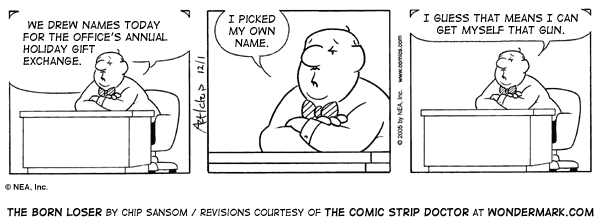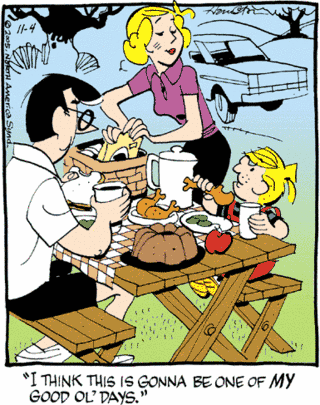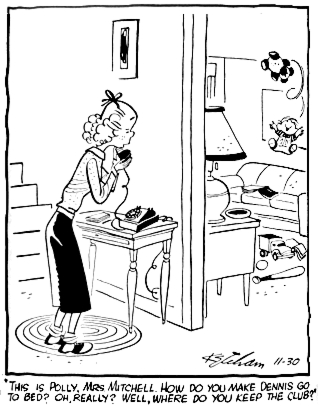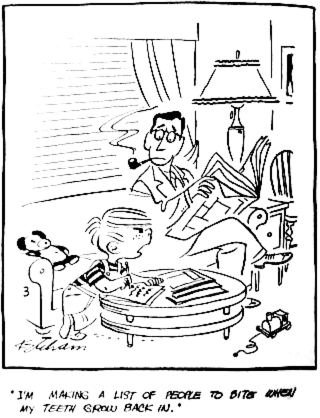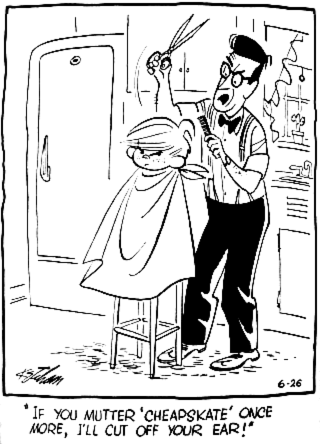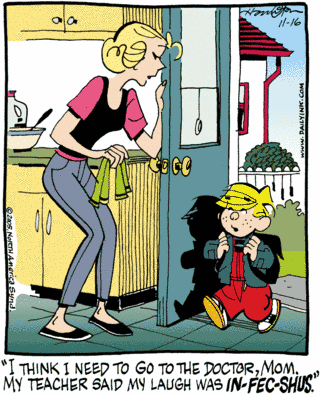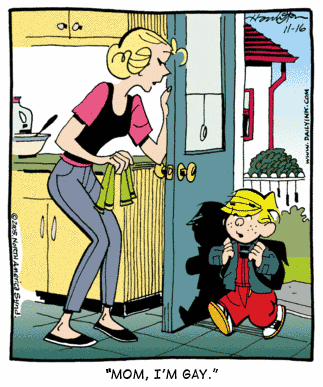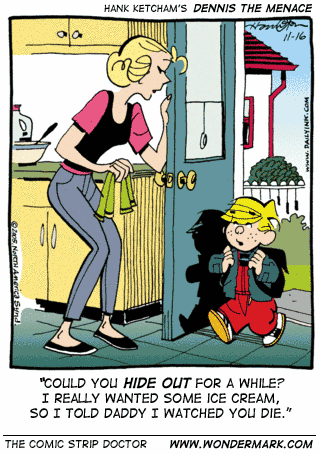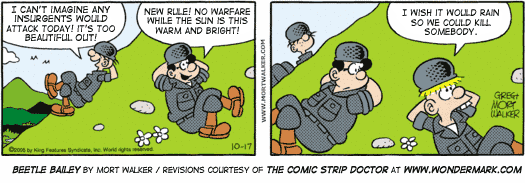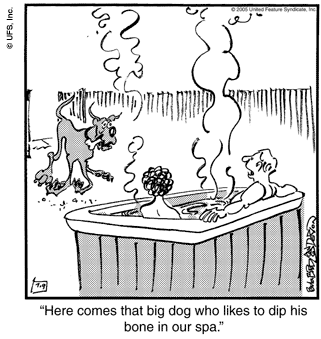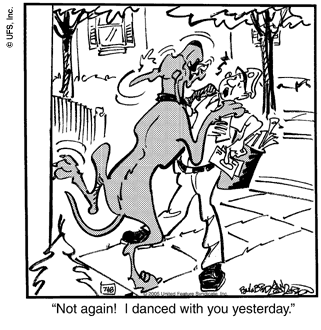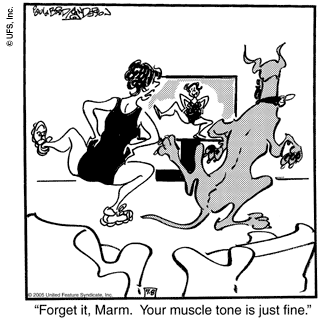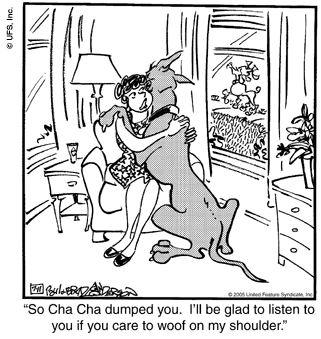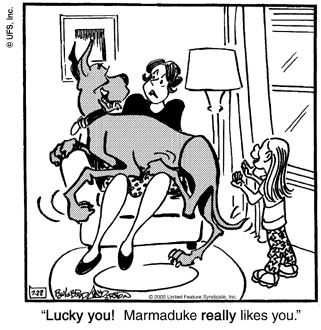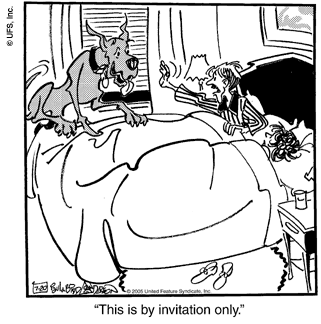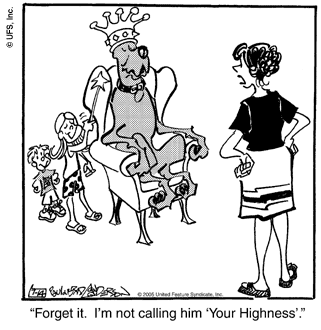
(Click any of the images to zoom in on them.)
What makes The Born Loser remarkable is not that it has graced the comics page for forty years; that’s barely middle-aged in the stagnant field of newspaper strips. It’s not that it’s steadfastly, reliably unfunny; Chip Sansom’s hardly got the monopoly on that. It’s not even that it’s now drawn by the original creator’s son; that’s definitely a given for a strip of its vintage — practically a requirement. It’s that it’s done all that and nobody has ever noticed it before. I’ll lay dollars to doorknobs that no Born Loser strip has ever entered into anyone’s long-term memory. It’s comic strip popcorn: fluffy, bad for you, and if you eat too much you’ll have the runs all night.
The Born Loser was created in 1965 by Art Sansom, who’d worked for twenty years as a fill-in artist for other comic strips whose creators were sick or otherwise indisposed. Having been thoroughly versed in hacking out the status quo, it was an easy transition to creating ineffectual pap of his own. The strip’s title character, Brutus Thornapple, is a poor put-upon for whom nothing ever goes right. He’s constantly abused by his wife (Gladys), mother-in-law (Mrs. Gargle), and boss (Mr. Veeblefester). His son, Wilberforce, is dumb. Thus begin and end the nuances of The Born Loser.
How, in a civilized society, does this happen? Why is this comic strip continually permitted to exist? As far as I can tell, there are no lucrative licensing agreements (as is the case with Dennis the Menace or Garfield), no throngs of fans fighting an imaginary values-based culture war (B.C.), and no secretive pacts with the unholy demon god Shabranigdo (Momma). Its only appeal is a lack of appeal. It’s a void in the universe that I wouldn’t even think was worthy of its own column — since nobody cares a whit about it — except for the fact that it is exemplary of a whole genre of comic strips: what I’ll call the ‘midlist’ (to borrow a term from the book industry).
‘Toplist’ comics (and I’m making up these categories) are the moneymakers: the Garfields and the Dilberts. They’re well-known, familiar, and (with some exceptions) pretty boring. In contrast, ‘bottomlist’ comics are (relatively) unknown, usually new to the arena, and if they succeed it’s because they’re fighting tooth and nail and delivering cold, hard quality. I would call Frazz a bottomlist comic (which should not be taken as a slight on its craft; I think it’s quite good). ‘Bottomlist’ shouldn’t be taken as a perjorative; it just means relatively unknown.
Midlist comics are the ones that exist in spite of their lack of profitable merchandising (like the toplists) or creative warmbloodedness (like the bottomlists). Fred Bassett is a midlist comic. The Lockhorns is a midlist comic. Frank & Ernest is a midlist comic.
There are so many shades of gray in any subject, comic strips included, that I’m a little uncomfortable inventing categories willy-nilly just for the sake of doing so. They’re inexact at best, and I hereby forbid anybody to ever use these categories for anything ever again. But for the sake of this column, they help me to draw a wide circle around a great swath of the comics page, excluding those properties with proven financial value to their owners and those with genuine creative appeal. Why do midlist comics persist?
The easy answer is, because it’s inevitable that a collection of syndicates taking a scattershot approach to building and retaining an audience will produce many poor works. The well-known Sturgeon’s Revelation states that “Ninety percent of everything is crap.” Certainly this holds true for comic strips as well. The more good works exist, the argument may follow, the more there will exist poor works.
Similarly, if the relative quality of creative works fall along a Bell curve of normal distribution, it would be expected that a large number of any sample will be of moderate and unexemplary quality, and a few will be of particular excellence or awfulness. In this case we should expect to find a large number of comics occupying the midlist ghetto.
And likewise, it should be expected that among the lifetime of a particular strip, there will exist individual comics of particularly low quality:
As well as particularly high quality (relative to the whole):
I cite the above as an example of relative “high quality” because, though clearly not innovative in its choice of subject matter or punchline, it atypically employs a visual gag (and a quite subtle one, at that). This is as good as The Born Loser gets, folks.
So, if we should expect that the majority of comics will fall into the midlist (according to our understanding of the laws of statistical distribution), we should be pretty okay with The Born Loser as it stands, right? I mean, it’s just occupying its space on the Bell curve. That’s just how the world works.
Except… the comics page does not exist in a vacuum. The list of titles on the page is mutable. There are thousands of cartoonists desperately trying to get into the business — even now, with webcomics as popular as they are. It would be possible — I daresay easy — to fill an entire newspaper page with good comics.
Of course, it will never happen. There are so many entrenched institutions that the only way to rebuild the house would be to bulldoze it and start over. Which, in a way, is what the web has allowed to happen — with the normal consequences of any creative medium with a low barrier to entry. If 90% of the comics page (say, 40 comics) is crap, what about 90% of the Internet? Oh No Robot hosts transcription services for over two hundred separate titles. Webcomics Nation, a paid hosting service for comics, has hundreds of subscribers. Comic Genesis is a free provider that hosts over six thousand different webcomics.
In theory, the profusion of comics on the Internet means that there exist lots of good comics, and that’s true. But in practice, what it also means is that new readers are less likely to find the good ones among the sea of everything, and more likely to get turned off to the concept in general. I don’t want to spend this column talking about webcomics, but it should be said that there are many, many quality strips that exist only online, and that a typical casual comic reader (a discerning fan of the best newspaper strips, even) will never, ever find them.
That’s why I think the concept of syndicates is a good one. They pick the cream of the crop, and distribute them to venues needing content. We shouldn’t have to suffer through the entire Bell curve of mediocrity and crap — the syndicates should be skimming from the good side and leaving the dreck to die.
But they don’t. There are many reasons: in the world of daily newspapers, reliability is valued over the more subjective “quality”; also, it’s accepted as common knowledge that audience taste follows roughly the same statistical distribution pattern as everything else. The prevailing wisdom is that the majority of the audience (which, in the case of newspapers, is roughly the population of the country) won’t “get” the most clever stuff, or don’t want to be intellectually challenged over their coffee. As H.L. Mencken famously said, “No one ever went broke underestimating the intelligence of the American people.”
Regardless of the intractable failings of the system, there is still plenty of room for improvement at the individual comic strip level. This strip, also reproduced above, will receive this column’s regular treatment:
In the first panel, Brutus stares into space, his desk devoid of anything that would remotely suggest that he’s actually employed. At least get a phone or something; no wonder Mr. Veeblefester hates you so much. Or are you just sitting in the supply closet?
Brutus: We drew names today for the office’s annual holiday gift exchange!
The exclamation point throws me. Judging by the expression on his face, Brutus is clearly not excited; instead, he seems to be speaking with emphatic disgust. The nerve! Those office-holiday-gift-exchange sons of bitches!
In the second panel, we get a closer look at Brutus’s dejected expression. Yup, he looks pretty run-down. Brutus sighs, and then there’s some sort of phlegmy vocalization (I guess that’s what the starry thing represents).
In the third panel, which may as well have been cut-and-pasted from the first, world-weary Brutus delivers the soul-crushing conclusion to his worthless story:
Brutus: I drew my own name!
Any normal person would simply unfold the paper, laugh, show it to the office manager with a shrug, fold it back up, drop it back in the bowl and pick another name. But Brutus didn’t. And I think I know why.
The easy explanation is that it’s simply an “idiot plot,” or a plot that only works if all the characters are idiots. It requires some suspension of disbelief in order to draw a strained conclusion. Most jokes are like this. I hate those jokes and refuse to abide them, and in fact I will interrupt their being told if I recognize them in time.
But in my optimistic view, I don’t think that’s the case here. I think there’s more material to be mined here than Chip Sansom realizes: this is a telling character moment. Brutus didn’t draw another name, even though he wanted to, because he’s just not that assertive. I picture him picking the paper from the bowl, sort of timidly and not making eye contact, and then unfolding the paper and seeing his own name — and by then the office manager had already gone to the next desk, laughing and being boisterous, and Brutus looked up and just couldn’t bring himself to clear his throat and say a single word.
In other words, what should make Brutus a “loser” is not that he drew his own name — that’s just weird luck and it could happen to anyone — but that he didn’t do anything about it.
If ever one could make a comic strip about a character whose single defining trait is his loser-ness, that’s the Brutus I want to read about. I want to see the Brutus who deeply, psychologically can’t cope with the mundane disappointments of everyday life, like Milton from Office Space.
I want to see Brutus go home after a long day at work, and far from being supportive, Gladys lays into him even worse than before — so he internalizes his frustration and smiles tight-lipped and wakes up very early in the morning and quietly leaves the house and drives for three hours into the sunrise and carefully, methodically kills a homeless person.
That’s comedy gold.
Until next time … I’ll see you in the funny papers.
— December, 2005





